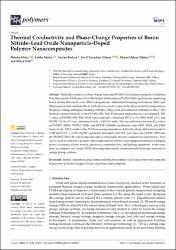Thermal conductivity and phase-change properties of boron nitride-lead oxide nanoparticle-doped polymer nanocomposites

View/
Access
info:eu-repo/semantics/openAccessDate
2023Author
Ortaç, BülendMutlu, Saliha
Başkan, Taylan
Savaşkan Yılmaz, Sevil
Yılmaz, Ahmet Hakan
Erol, Burcu
Metadata
Show full item recordCitation
Ortaç, B., Mutlu, S., Baskan, T., Savaskan Yilmaz, S., Yilmaz, A. H., & Erol, B. (2023). Thermal Conductivity and Phase-Change Properties of Boron Nitride-Lead Oxide Nanoparticle-Doped Polymer Nanocomposites. Polymers, 15(10), 2326. https://doi.org/10.3390/polym15102326Abstract
Thermally conductive phase-change materials (PCMs) were produced using the crosslinked Poly (Styrene-block-Ethylene Glycol Di MethylMethacrylate) (PS-PEG DM) copolymer by employing boron nitride (BN)/lead oxide (PbO) nanoparticles. Differential Scanning Calorimetry (DSC) and Thermogravimetric Analysis (TGA) methods were used to research the phase transition temperatures, the phase-change enthalpies (melting enthalpy ( Delta H-m), and crystallization enthalpies (Delta H-c)). The thermal conductivities (lambda) of the PS-PEG/BN/PbO PCM nanocomposites were investigated. The lambda value of PS-PEG/BN/PbO PCM nanocomposite containing BN 13 wt%, PbO 60.90 wt%, and PS-PEG 26.10 wt% was determined to be 18.874 W/(mK). The crystallization fraction (Fc) values of PS-PEG (1000), PS-PEG (1500), and PS-PEG (10,000) copolymers were 0.032, 0.034, and 0.063, respectively. XRD results of the PCM nanocomposites showed that the sharp diffraction peaks at 17.00 and 25.28 ffi C of the PS-PEG copolymer belonged to the PEG part. Since the PS-PEG/PbO and the PS-PEG/PbO/BN nanocomposites show remarkable thermal conductivity performance, they can be used as conductive polymer nanocomposites for effective heat dissipation in heat exchangers, power electronics, electric motors, generators, communication, and lighting equipment. At the same time, according to our results, PCM nanocomposites can be considered as heat storage materials in energy storage systems.

















